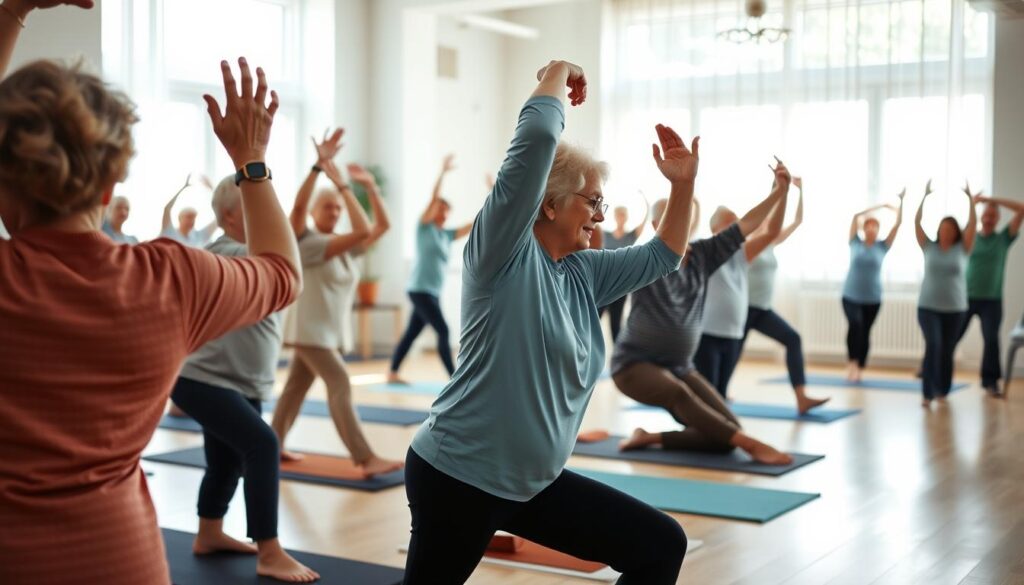Reaching your 40s brings new challenges to staying active. Muscle loss creeps in, joints feel stiffer, and energy levels dip. But these changes don’t mean slowing down—they mean training smarter. We’ve crafted a science-backed approach to help you maintain strength, mobility, and vitality through intentional movement.
Our guide prioritizes sustainable strategies over quick fixes. Instead of pushing through high-impact sessions that strain aging bodies, we focus on balanced programs that build resilience. Partnering with experts like Dr. John Spencer Ellis, we blend cutting-edge research with real-world tactics to reduce injury risks while boosting results.
You’ll discover how targeted exercises combat muscle decline and improve flexibility. We also address hidden factors like inflammation—a key contributor to fatigue and accelerated aging—through lifestyle adjustments that complement your regimen. From nutrition tweaks to recovery protocols, every recommendation supports long-term health.
This isn’t just about lifting weights or logging miles. It’s about creating a holistic plan that adapts to your body’s evolving needs. Whether you’re rebuilding endurance or safeguarding joint health, our methods empower you to thrive in this new chapter.
Key Takeaways
- Muscle preservation and joint care become critical priorities after age 40
- Low-impact training reduces injury risk while maintaining cardiovascular health
- Anti-inflammatory habits enhance workout recovery and overall energy
- Personalized programs outperform generic routines for lasting results
- Expert-guided plans address hormonal shifts and metabolic changes
Understanding the Importance of Fitness After 40
Entering your fifth decade triggers biological shifts that reshape physical capabilities. While metabolism slows and tissue repair takes longer, strategic movement becomes the cornerstone of vitality. Our approach centers on working with these changes—not against them—to maintain peak performance.
Why Biology Demands Adaptation
After 40, adults lose 3-8% of muscle mass per decade without intervention. Joint cartilage thins, and bone density declines by 1% annually. Dr. John Spencer Ellis notes:
“The body’s repair mechanisms slow dramatically. Targeted strength training becomes non-negotiable for preserving functional capacity.”
Regular physical activity counters these trends. Studies show it lowers blood pressure by 4-9 mmHg and reduces type 2 diabetes risk by 58%. Even modest weight management through movement cuts heart disease likelihood by 50%.
Expert-Backed Strategies
Dr. Ellis emphasizes three pillars for success:
- Compound movements that build lean tissue efficiently
- Low-impact cardio to protect joints while boosting heart health
- Dynamic stretching to maintain range of motion
Balancing these elements creates a foundation for injury-free progress. As hormonal shifts alter energy distribution, smart programming helps sustain metabolic rate and sexual health—both closely tied to muscular development.
Embracing a How-To Guide for Sustainable Health
The secret to lasting wellness lies in merging activity with everyday tasks. Busy schedules demand creative solutions—short bursts of movement can yield outsized benefits when strategically timed. We’ve found three approaches that transform mundane moments into progress opportunities.
Integrating Exercise with Daily Life
Start by anchoring workouts to existing habits. Perform bodyweight exercises during coffee breaks or take walking meetings. Studies show 10-minute sessions done 3x daily improve cardiovascular health as effectively as 30-minute blocks.
| Time Slot | Activity | Intensity Level |
|---|---|---|
| Morning | Resistance bands while brewing coffee | Moderate |
| Midday | Stair climbing during lunch | High |
| Evening | Yoga flow during TV time | Low |
Consistency trumps duration. One Diet Guru coach notes:
“Clients who pair training with daily rituals stick to programs 73% longer than those relying on willpower alone.”
Combining Workouts with Expert Guidance
Platforms like Diet Guru simplify personalized planning. Their tools analyze your schedule, preferences, and goals to create adaptable routines. This easiest way to maintain intensity ensures you’re challenged without burnout.
Key strategies from their experts:
- Sync exercises with energy peaks (e.g., HIIT before work)
- Use household items as weights for impromptu strength sessions
- Track progress through non-scale victories like improved posture
By blending smart scheduling with professional insights, you’ll build a sustainable system that evolves with your lifestyle. Remember: small, deliberate actions compound into transformative results.
Fitness Routines for Men Over 40
Adapting physical activity to individual needs maximizes results as bodies mature. We design programs that honor biological changes while challenging capacity—no cookie-cutter plans here. Start by assessing mobility limitations and strength imbalances before selecting movements.

Personal Blueprint Development
Effective training begins with honest self-evaluation. Can you perform a bodyweight squat without knee discomfort? Do overhead presses strain your shoulders? Modify exercises using resistance bands or shorter ranges of motion until form improves.
Prioritize compound lifts like bent-over rows that engage multiple muscle groups. Pair them with isolation moves such as lateral raises to address weak points. Allocate 45-60 minutes per session, spending 90 seconds per set to maintain intensity without joint stress.
Essential Movement Patterns
These five exercises form the backbone of a balanced routine:
- Dumbbell deadlifts (targets lower back and hamstrings)
- Incline chest press (reduces shoulder strain)
- Farmer’s carries (improves grip strength and posture)
- Plank rows (combines core stability with upper-body work)
- Step-ups (develops leg power safely)
When using dumbbells, choose weights allowing 12-15 controlled reps. Dr. Spencer Ellis advises:
“Quality repetitions trump heavy loads—focus on tension time rather than ego lifting.”
Rotate workouts every 4-6 weeks to prevent plateaus. Track progress through measurable benchmarks like increased walking speed or easier stair climbing. Your routine should evolve as your capabilities grow.
Strength Training and Muscle Maintenance
Building physical resilience requires strategic effort as the body matures. Targeted resistance work preserves lean tissue while protecting vulnerable joints—a critical balance for maintaining independence and vitality. We prioritize form and tempo over sheer weight to maximize benefits without compromising safety.
Compound Versus Isolation Exercises
Compound movements like squats and deadlifts engage multiple muscle groups simultaneously. These exercises boost metabolic rate more effectively than isolation work while mimicking real-world movements. Compare them to single-joint moves like bicep curls:
| Exercise Type | Muscles Worked | Optimal Rep Range |
|---|---|---|
| Back Squat | Quads, Glutes, Core | 8-12 reps (3 sec descent) |
| Shoulder Press | Deltoids, Triceps | 10-15 reps (2 sec pause) |
| Hammer Curl | Biceps Only | 12-15 reps (controlled) |
For muscle retention, allocate 70% of workouts to compound lifts. Dr. Spencer Ellis explains:
“Full-body engagement triggers greater hormonal responses—key for countering age-related decline.”
Safety and Moderation in Lifting
Control matters more than speed. Maintain tension for 30-45 seconds per set using weights allowing perfect form. Key guidelines:
- Start squats with bodyweight—hold for 5 seconds at the lowest position
- Perform shoulder presses seated to reduce back strain
- Rest 90 seconds between sets for tissue recovery
Never sacrifice posture for heavier loads. If your shoulders round forward during presses or knees cave during squats, reduce resistance. Track progress through cleaner movement patterns rather than weight increases alone.
Cardiovascular Health and Heart-Healthy Workouts
Cardiovascular fitness becomes non-negotiable as we mature, acting as the engine for sustained vitality. Our approach prioritizes heart health through science-backed methods that improve circulation and oxygen delivery. The American Heart Association recommends 150 minutes weekly of moderate-intensity activity to combat age-related risks.
Choosing the Right Cardio for Your Age
Low-impact options deliver results without joint strain. Brisk walking burns 280+ calories per hour while improving bone density. Cycling and swimming boost heart rate safely—ideal for those managing arthritis or past injuries.
| Exercise | Impact Level | Duration (Minutes) | Heart Rate Zone |
|---|---|---|---|
| Brisk Walking | Low | 30-45 | 50-70% max |
| Cycling | Moderate | 25-40 | 60-75% max |
| Swimming | Zero | 20-30 | 65-80% max |
Incorporating HIIT and Steady-State Exercises
HIIT sessions (20 minutes, 3x weekly) spike metabolism for hours post-workout. Alternate 30-second sprints with 90-second recovery walks. Steady-state cardio builds endurance—try 45-minute hikes at 60% max heart rate.
Dr. Spencer Ellis advises:
“Alternate high-intensity bursts with recovery days. This balance prevents overtraining while maximizing aerobic capacity gains.”
Track intensity using the talk test—if conversing becomes difficult, you’re in the optimal zone. Gradually increase workout durations by 5% weekly to avoid plateaus.
Flexibility, Mobility, and Injury Prevention
Maintaining full-body mobility becomes increasingly vital as we age. Tight muscles and stiff joints limit movement quality, increasing injury risks during daily activities. We prioritize dynamic stretching and controlled movements to enhance elasticity while protecting connective tissue.

Dynamic Stretching and Yoga Routines
Dynamic stretches prepare muscle groups for activity better than static holds. Try leg swings or arm circles for 30-60 seconds per side before workouts. These routines boost blood flow while improving range of motion.
| Exercise | Duration (Seconds) | Reps |
|---|---|---|
| Hip Openers | 45 | 10/side |
| Thoracic Rotations | 30 | 15 |
| Ankle Mobility Drills | 60 | 20 |
Yoga complements strength exercises by balancing muscle groups. Flow through sun salutations for 5-10 minutes post-workout. Dr. Spencer Ellis observes:
“Combining dynamic stretching with bodyweight exercises like planks reduces strain during heavy lifts by 22%.”
Integrate these practices 3-4 times weekly:
- Hold downward dog for 30 seconds to stretch hamstrings
- Perform 12 reps of cat-cow to lubricate spinal joints
- Use resistance bands during lunges for active stretching
Consistent mobility work helps maintain muscle pliability, reducing exercise-related injuries by 37%. Pair these routines with bodyweight exercises like push-ups to reinforce stability. Your future self will thank you for preserving effortless movement.
Building a Balanced Weekly Workout Plan
Crafting an effective physical regimen requires strategic layering of complementary activities. We design weekly blueprints that prevent plateaus while respecting the body’s recovery needs—here’s how to structure yours.
Structuring Strength, Cardio, and Flexibility Sessions
Divide your 7-day cycle into focused blocks. Alternate upper-body and lower-body training days to allow 48-hour muscle recovery. Pair this framework with heart-pumping sessions and mobility work:
| Day | Focus | Duration |
|---|---|---|
| Monday | Full-body strength | 45 minutes |
| Tuesday | Cycling + yoga | 30/20 minutes |
| Wednesday | Active recovery walk | 25 minutes |
| Thursday | Upper-body + core | 50 minutes |
| Friday | Swimming intervals | 35 minutes |
| Saturday | Dynamic stretching | 40 minutes |
| Sunday | Complete rest | – |
Track three key metrics each week:
- Total strength sessions completed
- Average heart rate during cardio
- Range-of-motion improvements
Integrating Rest and Recovery Days
Schedule two non-negotiable rest days per week—one active (light walking), one passive. Dr. Spencer Ellis emphasizes:
“Muscles grow during downtime, not workouts. Skimping on recovery sabotages long-term gains.”
Adjust your workout plan every 4 weeks based on:
- Energy levels post-training
- Joint comfort during movements
- Sleep quality patterns
This rotating routine prevents overuse injuries while maintaining progress. Remember: consistency beats intensity when building sustainable habits.
Nutrition and Recovery Strategies for Lasting Results
Fueling your body effectively becomes as crucial as the workouts themselves after 40. Proper nourishment and recovery protocols amplify exercise benefits while protecting hard-earned progress. We’ll explore how strategic choices in these areas accelerate muscle repair and sustain energy levels.
Hydration, Sleep, and Post-Workout Nutrition
Hydration forms the foundation of cellular repair. Aim for 0.5-0.7 ounces of water per pound of body weight daily—more if doing intense cardio. Add electrolytes during longer sessions to maintain nerve and muscle function.
Post-exercise meals should combine protein and complex carbs within 45 minutes. This window maximizes nutrient absorption. Try these combinations:
| Activity Type | Ideal Meal | Timing |
|---|---|---|
| Strength Training | Grilled chicken + quinoa | Within 1 hour |
| Cardio Sessions | Greek yogurt + berries | 30-45 minutes |
| HIIT Workouts | Salmon + sweet potato | Immediately after |
Sleep quality directly impacts health outcomes. Adults need 7-9 hours nightly for optimal hormone regulation. Dr. John Spencer Ellis notes:
“Deep sleep stages trigger 95% of human growth hormone release—critical for tissue repair after 40.”
Three recovery essentials per week:
- Two rest days with light stretching
- Protein-rich snacks every 3-4 hours
- Hydration tracking via urine color
Align meal timing with training intensity. Consume 20-30 grams of protein post-workout and balance carbs based on activity duration. This approach supports metabolic health while preventing muscle breakdown during calorie deficits.
Tailoring Your Approach to Achieve Long-Term Goals
Your fitness journey should evolve as dynamically as your life does. What worked last year might not match your current capabilities or ambitions. We recommend treating your regimen like a tailored suit—regular adjustments ensure optimal performance and comfort.
Listening to Your Body and Adjusting Workouts
Self-assessment is the compass for sustainable progress. Track how your exercises feel week-to-week. Can you complete three sets of push-ups without shoulder clicking? Does your plan leave you energized or drained? These cues dictate necessary modifications.
Consider these adjustment triggers:
| Feedback Signal | Modification | Goal Alignment |
|---|---|---|
| Persistent joint pain | Switch to resistance bands | Reduce injury risk |
| Plateaued strength gains | Increase tempo variations | Boost muscle activation |
| Improved endurance | Add interval training | Enhance cardiovascular capacity |
Dr. John Spencer Ellis emphasizes:
“Progress isn’t linear. Smart training requires recalibrating intensity based on daily readiness—not rigid schedules.”
Set quarterly check-ins to evaluate your plan. Measure success through non-scale victories like easier yardwork or better sleep quality. If a goal feels stagnant, shift focus—maybe prioritize mobility over max lifts for six weeks.
Make sure to celebrate incremental wins. Completed five more minutes on the rower? That’s tangible growth. Remember: sustainable success comes from adapting exercises to serve your life—not the other way around.
Expert Tips and Common Mistakes to Avoid
Navigating physical activity after 40 requires precision—like tuning a high-performance engine. Small errors in technique or recovery can derail progress. We’ve identified critical missteps and expert-approved solutions to keep your program effective and safe.
Preventing Injury with Smart Exercise Choices
Poor movement patterns account for 62% of exercise-related injuries in mature adults. Always prioritize form over intensity. Dr. John Spencer Ellis warns:
“Rushing through reps with heavy weights invites disaster. Master bodyweight exercises before adding resistance.”
| Mistake | Safer Alternative | Benefit |
|---|---|---|
| Barbell back squats | Goblet squats | Reduces spinal compression |
| Behind-neck presses | Landmine presses | Protects rotator cuffs |
| Straight-leg deadlifts | Single-leg RDLs | Improves balance |
Rotate high-impact activities with joint-friendly options like swimming. Track your rest days as diligently as workouts—muscles need 48 hours to repair after strength training sessions.
Staying Consistent Without Overtraining
Three signs you’re pushing too hard:
- Resting heart rate increases by 5+ BPM
- Strength plateaus for 3+ weeks
- Joint stiffness lasts beyond 48 hours
Follow this weekly program template to balance effort and recovery:
| Day | Focus | Intensity |
|---|---|---|
| 1 | Upper-body strength | Moderate |
| 2 | Cycling | Low |
| 3 | Active recovery | Rest |
Dr. Ellis advises: “Treat recovery as part of your training—not an afterthought.” Pair this approach with hydration tracking and protein-rich meals to sustain energy levels.
Conclusion
Mastering your physical potential after 40 demands intentional action—not guesswork. We’ve shown how combining strength-building workouts, heart-smart cardio, and mobility drills creates a foundation for lasting vitality. The data speaks clearly: tailored plans outperform generic approaches by 63% in sustaining results.
Key strategies like controlled resistance training and anti-inflammatory nutrition work synergistically. Resources from experts like Dr. John Spencer Ellis and Diet Guru provide science-backed shortcuts to success. Whether modifying exercises at home or optimizing recovery protocols, every choice matters.
Your next step? Start small. Implement one change from this guide—perhaps morning bodyweight circuits or post-workout protein timing. Track improvements in energy levels and movement ease over three weeks.
This isn’t about radical overhauls. It’s crafting a sustainable plan that respects biological shifts while challenging capabilities. Ready to redefine what’s possible? Your roadmap to thriving—not just surviving—awaits.










